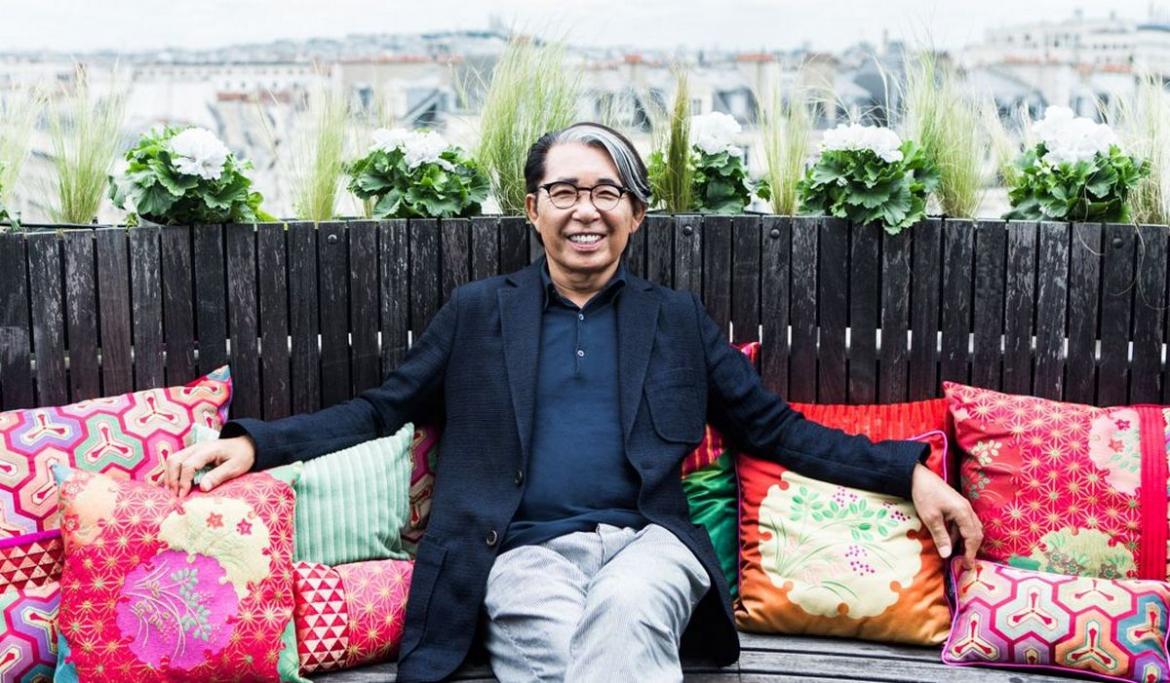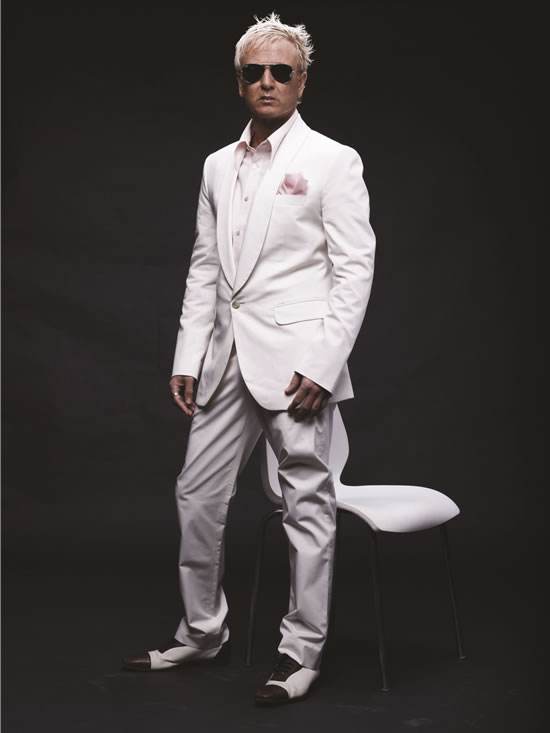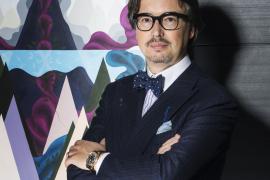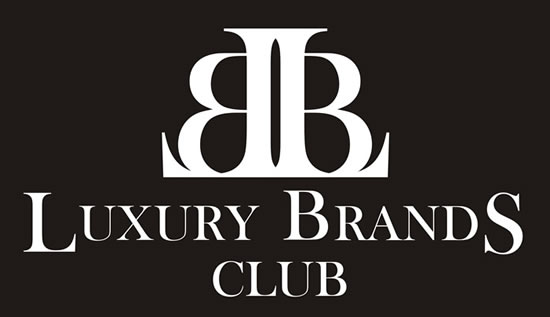Japanese fashion designer Kenzo Takada shot to the limelight in 1970 when he opened his boutique on Galerie Vivienne in Paris. Essentially inspired by the kimono, his styles captured the essence of a multicultural world and gave the world a whole new range of fashionable garments that were brightly coloured and trendy. He soon expanded into men’s fashion and in the perfume industry and his name has been synonymous with flamboyance and quality for the past 50 years. He stepped down from Kenzo in 1999, but that has not slowed him down one bit. He hasn’t stopped designing and creating ever since but he thinks back nostalgically of his life in the fashion world. The energy, the party like atmosphere, the people, the fast-paced life is what he misses the most.
In fact, he has recently collaborated with the French furniture company Roche Bobois whose designs resonate with his style and vibrancy. The Mah Jong sofa, designed by Kenzo is Roche Bobois’s signature piece along with an exceptional collection of fabrics and ceramics that have been created exclusively for Roche Bobois. Kenzo has reinterpreted the kimonos and created a collection of fabrics with three harmonious colour schemes for the sofa.
In a brief chat, we talk to Kenzo Takada about his inspiration, challenges, the road ahead and more.
Luxurylaunches – Your project with Roche Bobois is very different from your previous works, what inspired you to take it up?
Kenzo Takada – I met Nicolas Roche, Creative Director, Roche Bobois and his team, through mutual friends, over three years ago and quickly agreed that we should work together. We needed to decide on a theme, keeping in mind the project, and how it has its own identity. When we began, we chose 3 different topics but they were all around Japanese cultural influences, which is a great source of inspiration for me. At the end of the creative process, we agreed to work on the Mah Jong project. This iconic sofa is the most iconic furniture piece from Roche Bobois and I got attracted to the project as we could do so many things with it.
The main inspiration behind this project was the kimonos from the Noh theatre. I really wanted to bring a Japanese craftsmanship inspiration to the classic Mah Jong sofa. We initially worked around three different themes and chose to work on a Kimono influence. I have always admired Japanese Noh theatre and was strongly influenced by the patterns found on their kimonos. These designs and patterns are the inspiration behind this collection for Roche Bobois.
LL : What was it like to shift from fashion, where you were at the pinnacle, into the world of interiors?
KT : When I left the Kenzo brand in late 1999, early 2000, I really wanted to take a break and start to enjoy life. I had worked nonstop for 30 years with an intense rhythm. However, I quickly realized after a few months that I could not live without working. I have always loved interiors; it is something that started to interest me at a later stage in my life, so it was a natural progression for me. It has a definitely slower pace than fashion, which suits me better at my current age. You have more time to work on the design process, and the time frame for the designs that you create last for several years and not just a season.
Was it a challenge to work on the Mah Jong Sofa keeping its original design in mind, incorporating Roche Bobois distinctive style and adding your creative touch to it?
The collaboration between my team and Roche Bobois’s team worked really well. Roche Bobois gave me a lot of freedom, even though sometimes it was very challenging to understand certain technical aspects. They gave me full freedom to work on my ideas and their skilled team complimented my team beautifully. We got along really well and that allowed us to be very productive. Together we managed to accomplish creating this beautiful Collection.
A project that has been your highest achievement and one that has left you feeling disappointed through your long career
It is very hard to respond to this. But I can tell you that my biggest fear was to disappoint people. My goal was to really create products that people liked. Products that could vehicle an emotion, positivity, and joy. If I manage to do that on any kind of project, then that was an achievement.
I also engaged in a various project in my life, and some did not work. That can be very disappointing when you start realizing it is not what I was expecting. But now, looking back at the different venture, I can tell you that failing can sometimes be the best lesson to acquire experience and build knowledge.
Over a career that has spanned decades your inspiration has remained the kimono and variations of that with its styles and colours, is there any other source of your inspiration?
Definitely, the world is so rich, so vast, great history, the variety of cultures, arts, people; sources of inspiration can come from any direction. Just by talking to a friend, watching a great movie, a muse, or an object, I believe the inspiration is driven by the emotion triggered by the elements surrounding us every day.
What do you do when you feel you are getting creatively stuck?
It certainly happens, and I believe it happens to everyone. For me, the solution was to take a break, stop for a short time, travel, visit museums, trying to absorb new things. I tried and still, today try to remain as curious as possible.
To learn and to discover is one of the best skills of humankind, creativity follows.
What in your opinion will be the future of design or the next big thing in this field?
If I only could tell you, I would probably run the world. I was never a trend follower, and always did what I like to do with my team. What is the most important aspect of design and creativity for me is that it has to make sense. It has to be in harmony with the times.
What has been your biggest challenge in this field?
Every day is a challenge, this is why designing is so much fun for me. I learn new techniques every day, new technologies, new inspirations… I actually work because I love a little challenge, it is exciting.
If you were to go back in time, would you want to do anything differently?
I have been asked this question frequently, and I always say that I rather not look back. What has been done is in the past, and I try to look forward to see how I could use past experiences to improve the future.
The fashion industry today is very different from when you started off, which do you prefer and why?
These days, the fashion industry changes very fast, it is hard to keep up with it. I would say that there are perhaps more opportunities for young designers than ever before, it is probably more individualist, but much more accessible and I really love that about fashion today.
Do keep in mind that the competition is a lot fiercer with many great young talents. Though, the system has changed a lot, the distribution process is a lot more complex than before, the marketing aspects and tools have changed a lot, and the large groups changed the landscape. It really wasn’t like that when I started.
But I believe it is for the good in the long run.
What is important to you – creative force or commercial appeal?
This has always been a strong conflict in the creative world. I truly believe both commercial appeal and creative force must work in harmony. If there is no commercial aspect, then there is no creativity; if there are no sales, you can neither have a business nor creativity to apply it to.
Both are very important, and a good business is when you have the creative that gets along with the commercial aspect, then you have a chance.
What are your thoughts on Indian designs and motifs? Would we see an India inspired collection sometime?
Indian history is very rich; the colors are bright, joyful, very detailed. It is an amazing country and a culture I am deeply fond of. It definitely influenced me a lot; I have brought many textiles back with me from India on several occasions. Its fashion identity has definitely had an impact on my career.
The Indian fashion scene will soon become one of the most important markets in the world. I have visited India many times and have always loved it. I love the sari, the scarfs, the Kurta and the Jodhpur Jacket cuts. India carries a strong heritage of traditional clothing with incredible cuts that can be adapted for today and can influence a wide variety of designers.
The world of fashion, design, perfumes, and now interiors and furniture, what next?
Yes, Probably since I love starting new adventures, and working with companies that have great know how. I don’t work as much as I used to, but I don’t plan to stop anytime soon.









